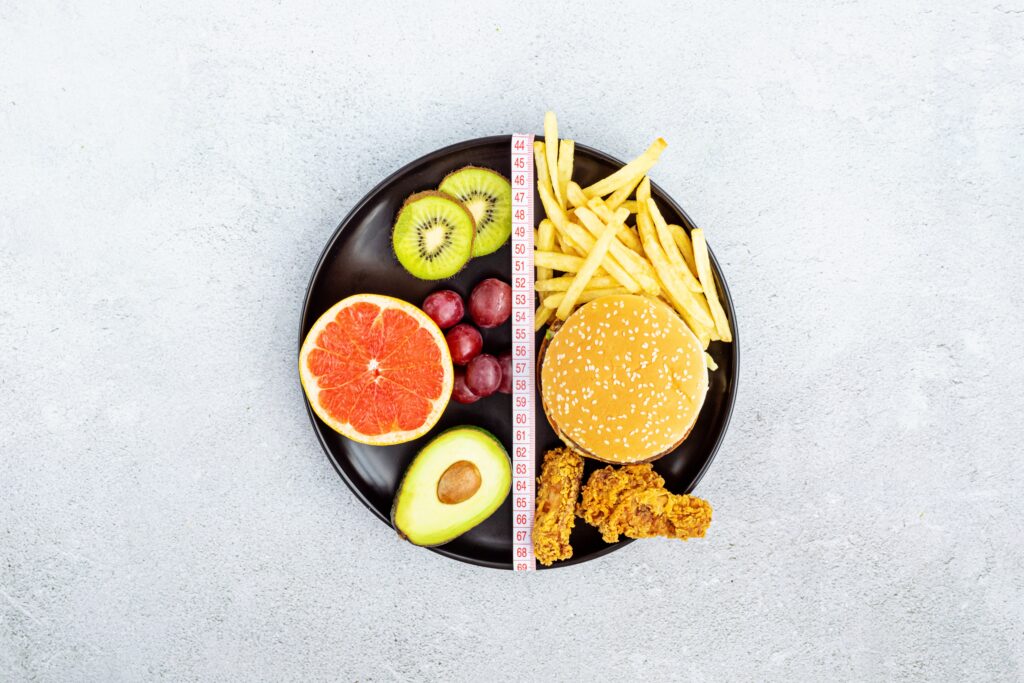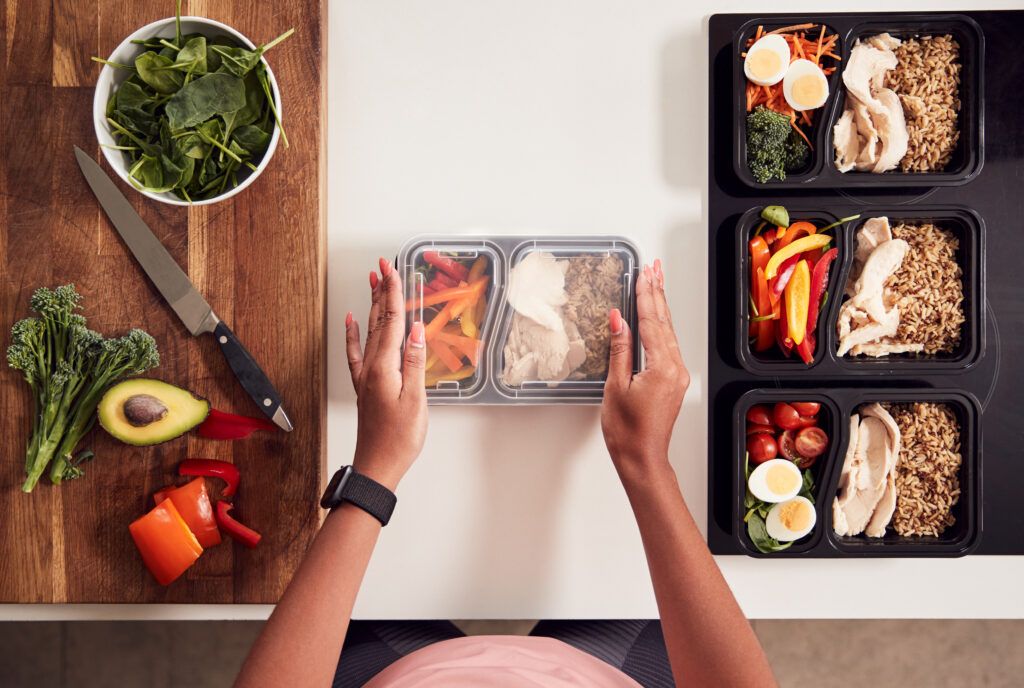Learn how to build a balanced diet that’s easy to follow with simple, sustainable tips for long-term health and well-being.
Confused about how to eat healthy? You’re not the only one. Unfortunately, there is no shortage of contradicting advice in the diet and nutrition world.
For instance, some say carbs are bad, while others remind us we need them to function well. In some circles, calorie restriction reigns supreme for weight loss, while others emphasize the importance of food quality over strict calorie tracking. You’ll find research that shows breakfast is crucial for boosting metabolism and curbing overeating, while other studies argue that skipping it and practicing intermittent fasting is a better way to boost metabolic health.
The truth is that nutrition is highly individual – there is no single best diet for everyone. What does apply to everyone, however, is the power of a balanced diet.
Deciphering the latest nutrition advice may be overwhelming, finding the right balance for your plate doesn’t have to be complicated or frustrating. In fact, a balanced diet can be simple and sustainable with a few easy strategies. Let’s break down what a balanced diet really is and share practical tips to help you make it a part of your daily routine.
What is a Balanced Diet?

A balanced diet is about more than just eating a variety of foods—it’s about making sure you get the right mix of nutrients to fuel your body and support overall health. This includes eating a combination of macronutrients (carbohydrates, proteins, and fats) and micronutrients (vitamins and minerals).
What it’s not? A fad diet or an extreme approach that eliminates whole food groups. Instead, it’s a way of eating that supports your energy levels, brain function, and overall physical health.
Why is eating a balanced diet so important? Beyond helping you simply feel better, this approach to eating could help you live a longer, healthier life. Research shows that an unbalanced diet—whether too high in refined sugars or lacking in essential nutrients—can lead to everything from digestive issues to chronic diseases. By aiming for a balanced diet, you’re not only fueling your body today, but you’re also protecting your long-term health.
The Recipe for a Balanced Diet

A well-rounded diet is like a recipe—each ingredient plays a key role in creating the perfect dish. For your body to function at its best, you need the right balance of macronutrients, micronutrients, and other essentials like fiber and hydration. Let’s take a closer look at what goes into the recipe for a balanced diet.
Understanding Macronutrients
Macronutrients—carbohydrates, proteins, and fats—are the primary building blocks of our diets. Each plays its own role in keeping your body in harmony:
Carbohydrates
Carbohydrates are your body’s go-to fuel source as they provide quick energy. But before you reach for a cookie, know that not all carbs are created equal. Simple, refined carbs may give you a quick boost, but lead to a sugar crash (along with inflammation and hormone imbalances). Instead, focus on complex carbs like whole grains, fruits, and vegetables, which release energy steadily throughout the day and support your well-being.
Proteins
Proteins are the building blocks for muscles, tissues, and even your immune system. Eating enough protein means you’ll be better equipped to repair and heal, make necessary hormones, and feel energized throughout the day. Balance your plate with proteins like lean meats, eggs, tofu, and legumes.
Fats
Fats are essential for brain function and absorbing fat-soluble vitamins your body needs, like A, D, E, and K. Avoid saturated or trans fats and opt for healthy fats from sources like avocado, olive oil, and nuts.
Carbohydrates, proteins, and fats are all essential for a balanced diet. But how much of each should you eat? Well, that can vary person to person. For most people, a balanced diet includes about 45-65% carbohydrates, 10-35% protein, and 20-35% fats. Consider your current diet and take note – about what ratio of carbs to protein to fat are you reaching? If it’s far off of this balance, you may want to find ways to balance it out. Or, reach out to our AlignLife functional nutritionists – they can help you determine the best balance for your unique body, lifestyle, and goals.
Incorporating Micronutrients
While macronutrients give you energy and structure, micronutrients (vitamins and minerals) are vital for supporting everything from your immune system to bone health.
Vitamins
There are 13 essential vitamins that your body needs to function properly. If you’re not feeling like your best self, you could be deficient in one or more of them. For instance, frequent colds could signal a lack of vitamins C, brain fog may be a sign you need vitamin D, and muscle fatigue could mean your B12 is low. Get these and other essential vitamins from colorful fruits and vegetables, healthy meats, fortified dairy, and leafy greens.
Minerals
Like vitamins, certain minerals (like calcium, magnesium, and zinc) are crucial for your health. These minerals maintain strong bones, steady heart rhythms, restorative sleep, immunity, and healthy skin. You can find them in foods like nuts, seeds, and whole grains.
Tracking micronutrients can be a bit more challenging than tracking your macronutrients. Here’s a simple shortcut: the more colorful your plate, the more variety of micronutrients you’re getting.
Other Building Blocks of a Balanced Diet

Beyond macronutrients and micronutrients, other elements play a key role in maintaining a balanced diet:
Fiber
Fiber helps your digestive system run smoothly and supports heart health. The best sources are fruits, vegetables, whole grains, and legumes.
Water
Hydration is often overlooked when it comes to diet, but water is just as essential as any food! Almost every bodily function, including digestion and temperature regulation rely on adequate water. Aim for 8 glasses a day, or more if you’re active.
Probiotics
We can’t talk about a balanced diet without mentioning gut health. A healthy gut will allow all the beneficial macro and micronutrients you eat to get properly absorbed and used by your body. A simple way to balance your gut health is with probiotics. Try adding in more fermented foods like yogurt, kimchi, or sauerkraut to maintain a healthy digestive system.
Building a Balanced Diet: Bite by Bite

Creating a balanced diet doesn’t have to be overwhelming or restrictive. It’s about making small, thoughtful choices that add up to big health benefits over time. By focusing on balance and variety in what you eat, you can nourish your body and support your well-being. Let’s break down how to build a balanced diet, one bite at a time.
Practical Tips for Easy Implementation
Practice Portion Control
In addition to thinking about what we eat, we also need to consider how much. Use your plate as a guide—half should be filled with vegetables, a quarter with lean protein, and the last quarter with whole grains or complex carbs.
Plan Every Meal
Planning ahead (and even preparing meals in advance) helps you stick to healthy options. Pick a day to plan and prep for the week ahead.
Make Healthy Snacks
Snack time can be a great way to sneak in some extra healthy nutrients into your diet. Swap processed snacks for nutrient-dense options like nuts, fruits, or veggie sticks with hummus.
How to Navigate Dietary Restrictions and Preferences
Dietary restrictions or picky food preferences can often lead us to eat the same things again and again. But, you can still enjoy a healthy, vibrant, balanced diet while navigating these needs or preferences.
Vegetarian or Vegan
No problem. Plant-based proteins like beans, lentils, and tofu are all healthy ways to balance your plate and fill your belly. Supplement these with whole grains, nuts, and seeds to ensure you’re getting enough nutrients.
Gluten-Free
Focus on naturally gluten-free grains like quinoa, rice, and buckwheat, along with plenty of fruits, vegetables, and lean proteins. Use processed gluten-free products sparingly, as these can be high in sugar and lower in nutrients. Instead, opt for whole, unprocessed foods whenever possible.
Food Allergies or Intolerances
Navigating food restrictions can be tricky, but you can often find alternative sources for restricted foods. For example, if you’re lactose intolerant, opt for calcium-fortified plant-based milks or leafy greens to meet your calcium needs. Meeting with a functional nutritionist can make finding the right foods for you much clearer!
Tips for Balancing Diet and Lifestyle
Your diet doesn’t exist in a vacuum—other lifestyle factors play a role in how well-balanced your eating habits are:
Exercise
Staying active helps you burn off excess calories and improves digestion. Plus, regular physical activity boosts your metabolism, making it easier to maintain a balanced diet.
Stress Management
Stress can lead to emotional eating or poor food choices. Managing stress is a personal journey, but relaxation techniques like chiropractic care, meditation, or yoga have been proven to help most people stay mindful of eating habits.
Sleep Quality
Did you know how well you sleep can affect how well you digest your meals? Getting enough sleep is essential for regulating hunger hormones and energy levels. Poor sleep can lead to cravings for high-calorie, sugary foods and disrupt your body’s ability to process nutrients efficiently. So, aim for 7-9 hours of quality sleep each night to support your overall diet and well-being. And if you still struggle to get some shut-eye, reach out to your chiropractor for help.
How to Track Progress and Make Adjustments
Did you know that data can help you with your diet? Tracking your diet can help you identify patterns and make adjustments when needed, so you’re more likely to stay on track with your balanced diet.
Get Evaluated
Striving for a balanced diet may seem simple, but other factors (like health goals, other health conditions, medications, schedule, and more) can complicate things. The most effective approach is to start with functional lab testing, evaluation, and meal planning with an AlignLife functional nutritionist.
Use an App
Apps like MyFitnessPal or Cronometer are great for logging food intake and monitoring your overall nutrition goals.
Check-in Regularly
Each day, take note of how you feel—whether your energy is consistent or if you’re experiencing cravings. This can help you adapt your diet as you find your best balance.
Start Eating a More Balanced Diet Today

A balanced diet is essential for living a healthy, active life, and it doesn’t have to be complicated or restrictive! Small, sustainable steps like these are all you need to start finding your balance. Try at least one of these tips (like drinking more water or adding a new colorful veggie to your dinner) today to take your first step.
If you’re ready to take control of your nutrition, AlignLife is here to help guide the way. Schedule a visit to your local AlignLife Center to learn more about how we can help you get started with small, personalized steps to more balanced eating – and better health.



